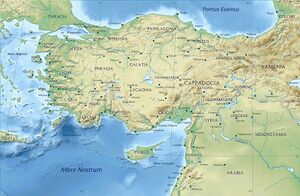Paphlagonia
| Author:Laxman Burdak, IFS (R) |

Paphlagonia was an ancient region on the Black Sea coast of north central Anatolia in Turkey.
Variants
- Paphlagonia and Paphlagonians (Anabasis by Arrian, p. 84, 305, 308.)
- Paphlagonia (Pliny.vi.2, Pliny.vi.39)
- Pylæmenia/Pylaemenia (Natural History by Pliny Book VI/Chapter 2)
- /ˌpæfləˈɡoʊniə/
- Greek: Παφλαγονία
- romanized: Paphlagonía,
- modern translit. Paflagonía
- Turkish: Paflagonya
Jat Gotras Namesake
Jat Gotras Namesake
- Pilania = Pylaemenia = Paphlagonia and Paphlagonians (Anabasis by Arrian, p. 84, 305, 308.)
Location
It is situated between Bithynia to the west and Pontus to the east, and separated from Phrygia (later, Galatia) by a prolongation to the east of the Bithynian Olympus. According to Strabo, the river Parthenius formed the western limit of the region, and it was bounded on the east by the Halys River. Paphlagonia was said to be named after Paphlagon, a son of the mythical Phineus.[1]
Geography
The greater part of Paphlagonia is a rugged mountainous country, but it contains fertile valleys and produces a great abundance of hazelnuts and fruit – particularly plums, cherries and pears. The mountains are clothed with dense forests, notable for the quantity of boxwood that they furnish. Hence, its coasts were occupied by Greeks from an early period. Among these, the flourishing city of Sinope, founded from Miletus about 630 BC, stood pre-eminent. Amastris, a few miles east of the Parthenius river, became important under the rule of the Macedonian monarchs; while Amisus, a colony of Sinope situated a short distance east of the Halys river (and therefore not strictly in Paphlagonia as defined by Strabo), grew to become almost a rival of its parent city.
The most considerable towns of the interior were 'Gangra – in ancient times the capital of the Paphlagonian kings, afterwards called Germanicopolis, situated near the frontier of Galatia – and Pompeiopolis, in the valley of the Amnias river, near extensive mines of the mineral called by Strabo sandarake (red arsenic or arsenic sulfide), largely exported from Sinope.
History
In the time of the Hittites, Paphlagonia was inhabited by the Kashka people, whose exact ethnic relation to the Paphlagonians is uncertain. It seems perhaps that they were related to the people of the adjoining country, Cappadocia, who were speakers of one of the Anatolian branch of the Indo-European languages. Their language would appear, from Strabo's testimony, to have been distinctive.
The Paphlagonians were one of the most ancient nations of Anatolia and listed among the allies of the Trojans in the Trojan War (ca. 1200 BC or 1250 BC, where their king Pylaemenes and his son Harpalion perished (Iliad, ii. 851–857). According to Homer and Livy, a group of Paphlagonians, called the Enetoi in Greek, were expelled from their homeland during a revolution. With a group of defeated Trojans under the leadership of the Trojan prince Antenor, they emigrated to the northern end of the Adriatic coast and later merged with indigenous Euganei giving the name Venetia to the area they settled.
Paphlagonians were mentioned by Herodotus among the peoples conquered by Croesus, and they sent an important contingent to the army of Xerxes in 480 BC. Xenophon speaks of them as being governed by a prince of their own, without any reference to the neighboring satraps, a freedom perhaps due to the nature of their country, with its lofty mountain ranges and difficult passes. All these rulers appear to have borne the name Pylaimenes as a sign that they claimed descent from the chieftain of that name who figures in the Iliad as leader of the Paphlagonians.
Mention by Pliny
Pliny[2] mentions....Beyond this river (river Billis) begins the nation of Paphlagonia1, by some writers called Pylæmenia2; it is closed in behind by the country of Galatia. In it are Mastya3, a town founded by the Milesians, and then Cromna4, at which spot Cornelius Nepos also places the Heneti5, from whom he would have us believe that the Veneti of Italy, who have a similar name, are descended.
1 Paphlagonia was bounded by Bithynia on the west, and by Pontus on the east, being separated from the last by the river Halys; on the south it was divided by the chain of Mount Olympus from Phrygia in the earlier times, from Galatia at a later period; and on the north it bordered on the Euxine.
2 In the Homeric catalogue we find Pylæmenes leading the Paphlagonians as allies of the Trojans; from this Pylæmenes the later princes of Paphlagonia claimed their descent, and the country was sometimes from them called Pylæmenia.
3 Suspected by Hardouin to have been the same as the Moson or Moston mentioned by Ptolemy as in Galatia.
4 It is mentioned by Homer, Il. ii. 855, as situate on the coast of Paphlagonia.
5 Strabo also, in B. xii., says that these people afterwards established themselves in Thrace, and that gradually moving to the west, they finally settled in the Italian Venetia, which from them took its name. But in his Fourth Book he says that the Veneti of Italy owe their origin to the Gallic Veneti, who came from the neighbourhood known as the modern Vannes.
External links
References
- ↑ Eustath. ad Horn. II. ii. 851, ad Dion. Per. 787; Steph. B. t.v.; Const. Porph. de Them. i. 7.
- ↑ Natural History by Pliny Book VI/Chapter 2
Back to Jat Places in Turkey

